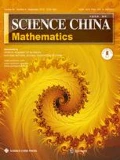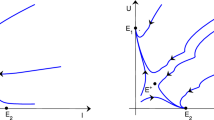Abstract
Dengue fever is caused by the dengue virus and transmitted by Aedes mosquitoes. A promising avenue for eradicating the disease is to infect the wild aedes population with the bacterium Wolbachia driven by cytoplasmic incompatibility (CI). When releasing Wolbachia infected mosquitoes for population replacement, it is essential to not ignore the spatial inhomogeneity of wild mosquito distribution. In this paper, we develop a model of reaction-diffusion system to investigate the infection dynamics in natural areas, under the assumptions supported by recent experiments such as perfect maternal transmission and complete CI. We prove non-existence of inhomogeneous steady-states when one of the diffusion coefficients is sufficiently large, and classify local stability for constant steady states. It is seen that diffusion does not change the criteria for the local stabilities. Our major concern is to determine the minimum infection frequency above which Wolbachia can spread into the whole population of mosquitoes. We find that diffusion drives the minimum frequency slightly higher in general. However, the minimum remains zero when Wolbachia infection brings overwhelming fitness benefit. In the special case when the infection does not alter the longevity of mosquitoes but reduces the birth rate by half, diffusion has no impact on the minimum frequency.
Similar content being viewed by others
References
Bian G W, Xu Y, Lu P, et al. The endosymbiotic bacterium Wolbachia induces resistance to dengue virus in Aedes aegypti. PLoS Pathog, 2010, 6: e1000833
Calisher C H. Persistent emergence of dengue. Emerg Infect Dis, 2005, 11: 738–739
Caspari E, Watson G S. On the evolutionary importance of cytoplasmic sterility in mosquitoes. Evolution, 1959, 13: 568–570
Casten R G, Holland C J. Stability properties of solutions to systems of reaction-diffusion equations. SIAM J Appl Math, 1977, 33: 353–364
Du Y H, Wang M X. Asymptotic behavior of positive steady-states to a predator-prey model. Proc Roy Soc Edinburgh Sect A, 2006, 136: 759–778
Farkas J Z, Hinow P. Structured and unstructured continuous models for Wolbachia infections. Bull Math Biol, 2010, 72: 2067–2088
Friedman A. Partial Differential Equations of Parabolic Type. Englewood Cliffs, NJ: Prentice-Hall, 1964
Henry D. Geometric Theory of Semilinear Parabolic Equations. Lecture Notes in Math, vol. 840. Berlin-New York: Springer-Verlag, 1981
Hirsch M W, Smale S, Devaney R. Differential Equations, Dynamical Systems, and an Introduction to Chaos, 2nd ed. Orlando: Academic Press, 2003
Hoffmann A A, Montgomery B L, Popovici J, et al. Successful establishment of Wolbachia in Aedes populations to suppress dengue transmission. Nature, 2011, 476: 454–457
Hoffmann A A, Turelli M, Harshman L G. Factors affecting the distribution of cytoplasmic incompatibility in Drosophila simulans. Genetics, 1990, 126: 933–948
Keeling M J, Jiggins F M, Read J M. The invasion and coexistence of competing Wolbachia strains. Heredity, 2003, 91: 382–388
Kyle J L, Harris E. Global spread and persistence of dengue. Annu Rev Microbiol, 2008, 62: 71–92
Lin C S, Ni W M, Takagi I. Large amplitude stationary solutions to a chemotaxis system. J Diff Equ, 1988, 72: 1–27
Lou Y, Ni W M. Diffusion, self-diffusion and cross-diffusion. J Diff Equ, 1996, 131: 79–131
Mcmeniman C J, Lane R V, Cass B N, et al. Stable introduction of a life-shortening Wolbachia infection into the mosquito Aedes aegypi. Science, 2009, 323: 141–144
Mottoni P D, Rothe F. Convergence to homogeneous equilibrium state for generalized Lotka-Volterra systems with diffusion. SIAM J Appl Math, 1979, 37: 648–663
Ni W M, Tang M X. Turing patterns in the Lengyel-Epstwin system for the CIMA rection. Trans Amer Math Soc, 2005, 357: 3953–3969
Ormaetxe I I, Walker T, O’Neill S L. Wolbachia and the biological control of mosquito-borne disease. EMBO Reports, 2011, 12: 508–518
Pang Y H, Wang M X. Qualitative analysis of a ratio-dependent predator-prey system with diffusion. Proc Roy Soc Edinburgh Sect A, 2003, 133: 919–942
Peng R, Shi J P, Wang M X. Stationary pattern of a ratio-dependent food chain model with diffusion. SIAM J Appl Math, 2007, 67: 1479–1503
Protter M H, Weinberger H F. Maximum Principles in Differential Equations. Berlin-New York: Springer-Verlag, 1984
Turelli M. Evolution of incompatibility-inducing microbes and their hosts. Evolution, 1994, 48: 1500–1513
Turelli M. Cytoplasmic incompatibility in populations with overlapping generations. Evolution, 2010, 64: 232–241
Turelli M, Hoffmann A A. Rapid spread of an inherited incompatibility factor in California Drosophila. Nature, 1991, 353: 440–442
Turelli M, Hoffmann A A. Microbe-induced cytoplasmic incompatibility as a mechanism for introducing transgenes into arthropod populations. Insect Mol Biol, 1999, 8: 243–255
Walker T, Johnson P H, Moreira L A, et al. The wMel Wolbachia strain blocks dengue and invades caged Aedes aegypti populations. Nature, 2011, 476: 450–453
Weinberger H F. Invariant sets for weakly coupled parabolic and elliptic systems. Rend Mat, 1975, 8: 295–310
Xi Z Y, Khoo C C, Dobson S L. Wolbachia establishment and invasion in an Aedes aegypti laboratory population. Science, 2005, 310: 326–328
Zheng B, Tang M X, Yu J S. Modeling Wolbachia spread in mosquitoes through delay differential equation. SIAM J Appl Math, 2014, 74: 743–770
Zhou L, Pao C V. Asymptotic behavior of a competition diffusion system in population dynamics. Nonlinear Anal Theor Meth Appl, 1982, 6: 1163–1184
Author information
Authors and Affiliations
Corresponding author
Rights and permissions
About this article
Cite this article
Huang, M., Tang, M. & Yu, J. Wolbachia infection dynamics by reaction-diffusion equations. Sci. China Math. 58, 77–96 (2015). https://doi.org/10.1007/s11425-014-4934-8
Received:
Accepted:
Published:
Issue Date:
DOI: https://doi.org/10.1007/s11425-014-4934-8
Keywords
- dengue fever
- Wolbachia infection dynamics
- cytoplasmic incompatibility
- reaction diffusion equations
- asymptotic stability




